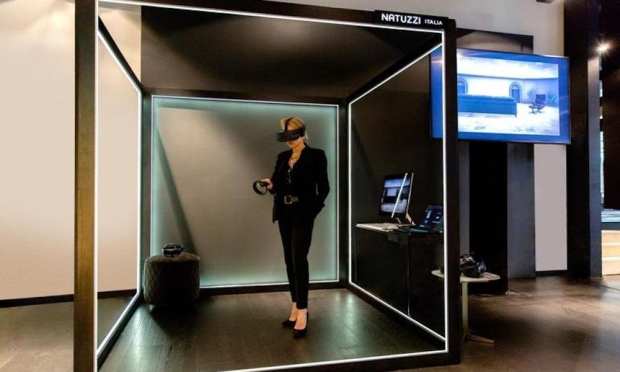Fixing The Friction In Furniture With VR And Holograms

Italian luxury furniture brand Natuzzi has not historically been known for high-tech offerings. Founded in 1959 by Pasquale Natuzzi, the brand’s began as a three-man shop dedicated to building handmade furniture for a local open-air market. Pasquale Natuzzi still heads the brand today, 60 years later, but it has come quite a long way from its humble origins.
Since the 1980s the brand has been pursuing global growth, has had a strong presence in the U.S since the 1990s and today operates 274 Natuzzi stores worldwide (mainly in Italy, Greece, Spain, Portugal, France, Switzerland, China and Australia) as well as 335 Natuzzi Galleries, mainly in the United States and Northern Europe.
The question for the brand as it begins sixth decade of operations, however, is in how it can expand more and create a better shopping experience — without the headwinds that have typically plagued expansion. Furniture galleries and stores require large physical footprints and thus entail a lot of overhead. Moreover moving stock in and out of the spaces presents no shortage of logistical challenges since furniture is often large, cumbersome and heavy.
Which is why the brand has begun experimenting with a holographic project and virtual reality (VR) in its physical stores to allow consumers to see and experience furniture and how it will look in their own home, without necessarily having to physically interact with any specific piece. The VR magic is currently being managed care of Microsoft HoloLens 2 headset at Natuzzi’s Tottenham Court Road shop in London, which now provides a dedicated space for users to come in and digitally decorate a 3D rendering of their living room.
Shoppers, according to Natuzzi, are no longer limited to what happens to be in stock in any particular location, and instead gain access to an “endless virtual showroom” where they can, if they so desire, browse through the catalogue of every single piece of furniture created by Natuzzi designers.
To make sure the customer is looking at their own living room for this process — as opposed to a generic space — ahead of the use of the 3D digital design station consumers submit photos and measurements of the space so it can be accurately digitally recreated for use within the system.
The main advantage of the VR expansion, explained Pasquale Junior Natuzzi, creative director and stylist for the firm, is that it removes the main friction customers encounter when they are out in the real world shopping for furniture — they see a lot of pieces out of context, which makes them hard to judge. Clothing can be tried on, and if it is a bad fit rejected. Furniture, until recent advances in technology, really couldn’t be previewed in the same way.
“We’ll let them walk their home virtually,” he told ZDNet. “They won’t need to walk through aisles of similar products — instead they can have a fun and experiential tour of their own home with a selection of Natuzzi furniture.”
Moreover, it allows the shopper to get the smallest details of the purchase right. Customers often find they like something in a furniture shopping process — except for one thing about it. It is the right fabric, but not quite the right color, Natuzzi said, or it is the right color, but not quite the right shade. Sometimes it is everything the customer wants, but perhaps slightly too large for the room they are furnishing.
With a virtual reality headset, all of the guesswork that happens in the store theoretically falls by the wayside, and customers create objects in their digital living room and optimize them before making a final choice. And a customer who can customize their purchase, Natuzzi said, is also a customer more likely to complete the purchase. The brand reports that its number of conversion from presentations with the use of the VR tech has increased by as much as a third.
Which means the HoloLens will continue its march throughout the brand’s stores worldwide. Today the HoloLens technology is only in two of Natuzzi’s locations — in New York and London. But the global rollout is set to start next year. Because, as the creative director noted, the world of retail is changing. That has been the case for all 60 years the firm has been in business, but today the messages are louder and more constant than they’ve ever been — which means Natuzzi is thinking not just about how to make and sell furniture, but about all the ways it can make those sales stand out.
“Consumers are bombarded with brand messaging through all sorts of online and physical channels,” said Natuzzi, “so it’s important that we find unique ways to present our products and value our proposition to customers.”
